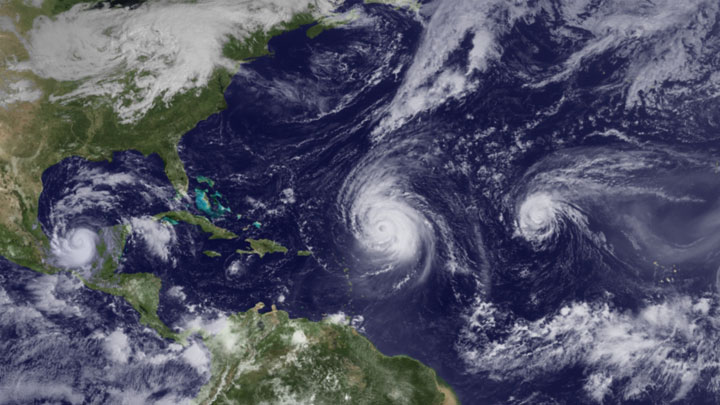TORONTO – With the release of the National Oceanic and Atmospheric Administration’s (NOAA) 2014 hurricane season forecast, we take a look back at the last five years.

There are a few factors that NOAA uses to calculate whether or not it is going to be or was a normal, above-normal, or below-normal hurricane season. The most obvious factor is the number of hurricanes. But another factor is something called the Accumulated Cyclone Energy (ACE), a wind energy index that is measured every six hours during a tropical storm’s life.
READ MORE: 2013 tied for 4th warmest year on record, NOAA
Until 2011, NOAA used the 1950 to 2000 statistics to calculate seasonal averages. That was, 11 named storms, six hurricanes and two major hurricanes. The new averages used are from 1981-2010, which corresponds to 12 named storms, six hurricanes, and three major hurricanes. The ACE range is 71.4 to 120 per cent.
2009 Forecast
- 50 per cent chance of a near-normal season, a 25 per cent chance of an above-normal season, and a 25 per cent chance of a below-normal season
- 9-14 named storms
- 4-7 hurricanes
- 1-3 major hurricanes
- An ACE range of 65-130 per cent of the median
Reality check: Below normal; NOAA’s forecast falls short.
- 9 named storms
- 3 hurricanes
- 2 major hurricanes
- an ACE range was 60 per cent of the median

2010 Forecast
- 85 per cent chance of an above-normal season, 10 per cent chance of a near-normal season, and a 5 per cent chance of a below-normal season
- 14-23 named storms
- 8-14 hurricanes
- 3-7 major hurricanes
- an ACE range of 155-270 per cent of the median
Reality check: Above normal; NOAA’s forecast is accurate.
- 19 named storms
- 12 hurricanes
- 5 major hurricanes
- an ACE range was 190 per cent of the median
2011 forecast
- a 65 per cent chance of an above-normal season, a 25 per cent chance of a near-normal season, and a 10 per cent chance of a below-normal season
- 12-18 named storms
- 6-10 hurricanes
- 3-6 major
- an ACE range of 105-200 per cent of the 1981-2010 median
Reality check: Above normal; NOAA’s forecast is accurate.
- 19 tropical storms
- 7 hurricanes
- 4 major hurricanes
- an ACE value of 138 per cent of the 1981-2010 median
2012 forecast
- Roll Up To Win? Tim Hortons says $55K boat win email was ‘human error’
- Bird flu risk to humans an ‘enormous concern,’ WHO says. Here’s what to know
- Halifax homeless encampment hits double capacity, officials mull next step
- Ontario premier calls cost of gas ‘absolutely disgusting,’ raises price-gouging concerns
- a 50 per cent chance of a near-normal season, a 25 per cent chance of an above-normal season, and a 25 per cent chance of a below-normal season
- 9-15 named storms
- 4-8 hurricanes
- 1-3 major hurricanes
- an ACE range of 65-140 per cent of the median
Reality check: Above normal; NOAA’s forecast falls short.
- 19 tropical storms
- 10 hurricanes
- 2 major hurricanes
- an ACE value of 144 per cent of 1981-2010 median
2013 forecast
- a 70 per cent chance of an above-normal season, a 25 per cent chance of a near-normal season, and only a five per cent chance of a below-normal season
- 13-20 named storms
- 7-11 hurricanes
- 3-6 major hurricanes
- an ACE range of 120-205 per cent
Reality check: Fewest number of hurricanes since 1982; 10th least-active Atlantic hurricane season since 1950; NOAA’s forecast was highly inaccurate.
- 15 tropical storms
- 2 hurricanes
- No major hurricanes
- an ACE value of 31.1 per cent the median
Forecasting hurricanes is dependent on several factors, and recently some scientists have suggested not releasing any numbers for hurricane forecasts. For the surprisingly low 2013 season, NOAA said that an “unpredictable atmospheric pattern” prevented the growth of storms. This year, there is uncertainty about the El Nino effect, which tends to suppress tropical storm formation.


Comments